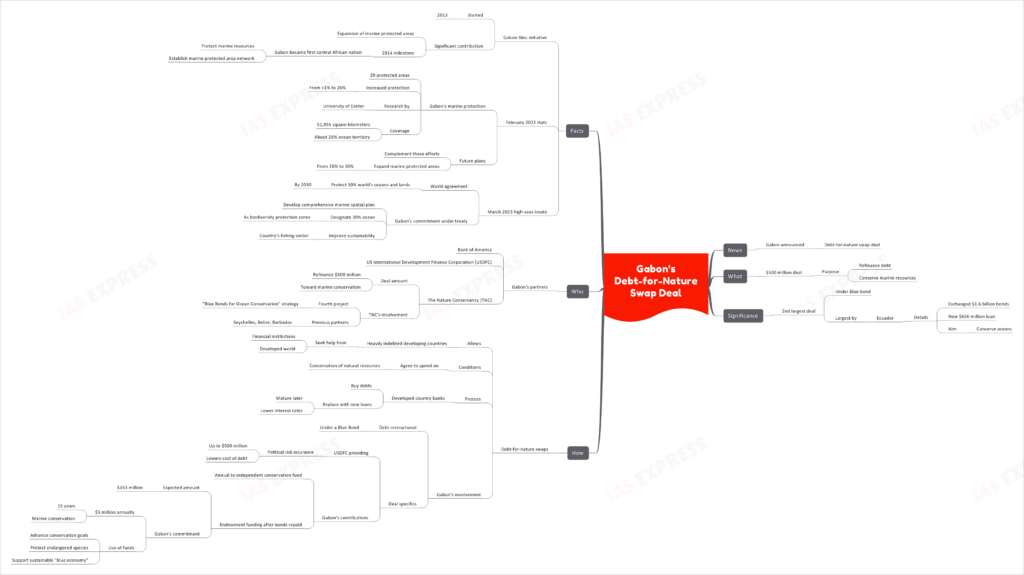Gabon’s Debt-for-Nature Swap Deal

Gabon has publicly announced its participation in a debt-for-nature swap deal, which aims to both refinance national debt and bolster marine conservation efforts.
This topic of “Gabon’s Debt-for-Nature Swap Deal” is important from the perspective of the UPSC IAS Examination, which falls under General Studies Portion.
Overview
The Deal
- Amount: $500 million.
- Primary Purpose: Refinance Gabon’s debt and conserve marine resources.
Significance
- Gabon’s deal stands as the 2nd largest under the blue bond initiative, overshadowed only by Ecuador’s previous endeavor:
- Ecuador exchanged bonds worth $1.6 billion for a new loan of $656 million, earmarked for ocean conservation.
Mechanics
- Debt-for-Nature Swaps:
- Allows developing nations grappling with heavy debt to collaborate with financial institutions and developed countries.
- Under these agreements, the participating nations commit to natural resource conservation.
- Developed country banks acquire these debts and provide alternative loans that mature later and often carry reduced interest rates.
- Gabon’s Involvement:
- Gabon’s debt was restructured under a Blue Bond.
- Specifics:
- US International Development Finance Corporation (USDFC) offered political risk insurance up to $500 million, reducing Gabon’s debt costs.
- Gabon’s side of the deal includes annual contributions to an independent conservation fund and an endowment fund post bond repayment, anticipated to reach $163 million.
- Gabon has vowed to provide $5 million annually for 15 years to marine conservation.
- Utilization of the funds will encompass promoting conservation goals, safeguarding endangered species, and buttressing the sustainable “blue economy”.
Key Stakeholders
- Gabon’s Collaboration Partners:
- Bank of America.
- US International Development Finance Corporation (USDFC).
- The Nature Conservancy (TNC):
- The deal’s amount, a total of $500 million, is directed towards marine conservation.
- For TNC, this marks their fourth project under the “Blue Bonds for Ocean Conservation” strategy. Their prior collaborations were with Seychelles, Belize, and Barbados.
Background & Facts
- Gabon Bleu Initiative:
- Launched in 2013.
- Notable achievements include the expansion of marine protected zones.
- Gabon, in 2014, became the inaugural central African country to take significant measures for marine resource protection by setting up a marine protected area network.
- February 2022 Data:
- Gabon currently boasts 20 marine protected areas.
- Marine conservation zones have expanded from less than 1% to 26%, covering a vast 51,955 square kilometers (approx. 26% of their ocean territory) as found by research from the University of Exeter.
- Gabon’s ambitions don’t end here. They plan to elevate their marine protected regions from 26% to a commendable 30%.
- March 2023 High-Seas Treaty:
- A global pact aiming to shield 30% of the world’s oceans and lands by 2030.
- Under this agreement, Gabon is on track to:
- Draft a thorough marine spatial strategy.
- Designate 30% of its oceanic expanse as biodiversity protection zones.
- Enhance the sustainable practices within its fishing industry.

